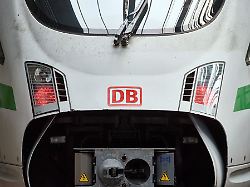Tempo, expansion, night work
What Deutsche Bahn can learn from other countries
08/13/2023, 8:22 p.m
In Germany, the railway is primarily considered to be chronically unpunctual. A look abroad shows that the trains are more reliable here. But what do Japan, Italy or Switzerland do better?
It’s not always fair to refer to other countries like Japan given the unreliability of Deutsche Bahn. But anyone who is waiting for a late ICE train at the train station, or who has to sprint to the other end of the platform or even to another platform because of a reversed row of carriages, still thinks longingly of conditions like in the Far East Asian country. Delays are so rare there that the media promptly pick them up as main news when they do occur. But can Deutsche Bahn really learn something from other countries?
In many places, the trains are more reliable than in Germany. However, the values are only comparable to a limited extent. On the one hand, punctuality is defined and measured differently in each case. In addition, the German rail network is the largest and one of the most complex in Europe and therefore presents the operators with special challenges. Nevertheless, the subject of railways has been approached in other countries with much more courage for many years.
Switzerland: Slowly but on time
In Switzerland, 92.5 percent of trains were on time last year. That means they were less than three minutes late. In Germany, a train is still considered punctual if it is delayed by up to six minutes. The Swiss railways (SBB) rely more on smooth traffic instead of high-speed trains like the ICE. The train journey therefore often takes a little longer than on a comparable ICE route, but punctual arrival is more or less guaranteed. In addition, the trains have wide doors so that boarding and alighting is quicker. Reservations are not common. There are mainly double-decker trains, in which there are usually seats.
The Swiss have one of the densest railway networks in the world. Of course, the distances in the small country are much shorter than in Germany. The German rail network is about seven times as large. The country invests – calculated on the respective size – every year about twice as much in operation and maintenance as Deutsche Bahn.
Italy: billions invested in the expansion
With around 16,800 kilometers, the Italian route network is just half the size of the German one. However, the Italian state has expanded the long-distance transport network in particular in recent years and is planning billions in investments in modernization and expansion for the past few years.
In the current year, rail traffic has been affected by several strikes, which have led to severe restrictions such as delays and train cancellations. However, the Italian state railway Ferrovie dello Stato Italiane (FS) announced that the punctuality index of high-speed trains in 2022 was around 78 percent. In the first half of 2023 he reached 80.2 percent. The same applies to regional trains. For the FS, a train that is ten minutes late is still considered punctual.
Japan: Work is done at night
In Germany, freight, regional and long-distance trains share one and the same rail network. Japan, on the other hand, has created a separate network for the Shinkansen bullet trains. On these routes, trains can accelerate to more than 320 kilometers per hour without having to take slower passenger and freight trains into account. In addition, maintenance work in Japan is almost always carried out during the nightly break in operation. In Japan, it would be unthinkable to shut down lines for months. In addition, the stop times at Japan’s train stations and the frequency of the trains are short, despite the transport of large crowds. The downside is that many trains are totally overcrowded at peak times.
Ukraine: Repair immediately
According to a spokeswoman, even the Ukrainian railways had a punctuality rate of 87 percent. At Deutsche Bahn, 91.7 percent of the trains were punctual in all passenger traffic in the same period. In Ukraine, however, even the smallest delay is recorded, “even if it’s just a minute,” as they say.
The state railway Ukrzaliznytsia is considered the backbone for traffic in the country, which was shaken by the Russian war of aggression. The government is therefore very keen to repair destroyed routes as quickly as possible.
Even if punctuality was high in the first half of the year, rail transport can hardly be compared to that in Germany. According to its own information, the Ukrainian railway recorded around 24,700 journeys in passenger traffic in the first half of the year. With Deutsche Bahn alone, there are 20,000 long-distance journeys per month plus a further 780,000 in regional transport.
Germany will need years to catch up
The high rate of unpunctuality on the railways is mainly due to the largely outdated and maintenance-requiring route network. For decades, investments in expanding and renovating the tracks were neglected. Data from the Pro-Rail Alliance shows that Germany has been one of the countries in Europe with the lowest per capita investments in its own rail network for years.
Only in the past few years have there been increasing signs that the federal government wants to change course: “We will do everything we can to continue the massive investment ramp-up in the coming years – with the goal reinforced in the coalition decision of March of up to an additional 45 billion euros by 2027 to make it available,” Federal Transport Minister Volker Wissing (FDP) recently confirmed.
Routes with heavy traffic are to be gradually modernized in the coming years through general renovation. With the Deutschlandtakt, a long-distance train is to connect the major cities with each other every half hour. However, it will probably be a few years before these measures are also felt by passengers. Other countries are already well ahead.
